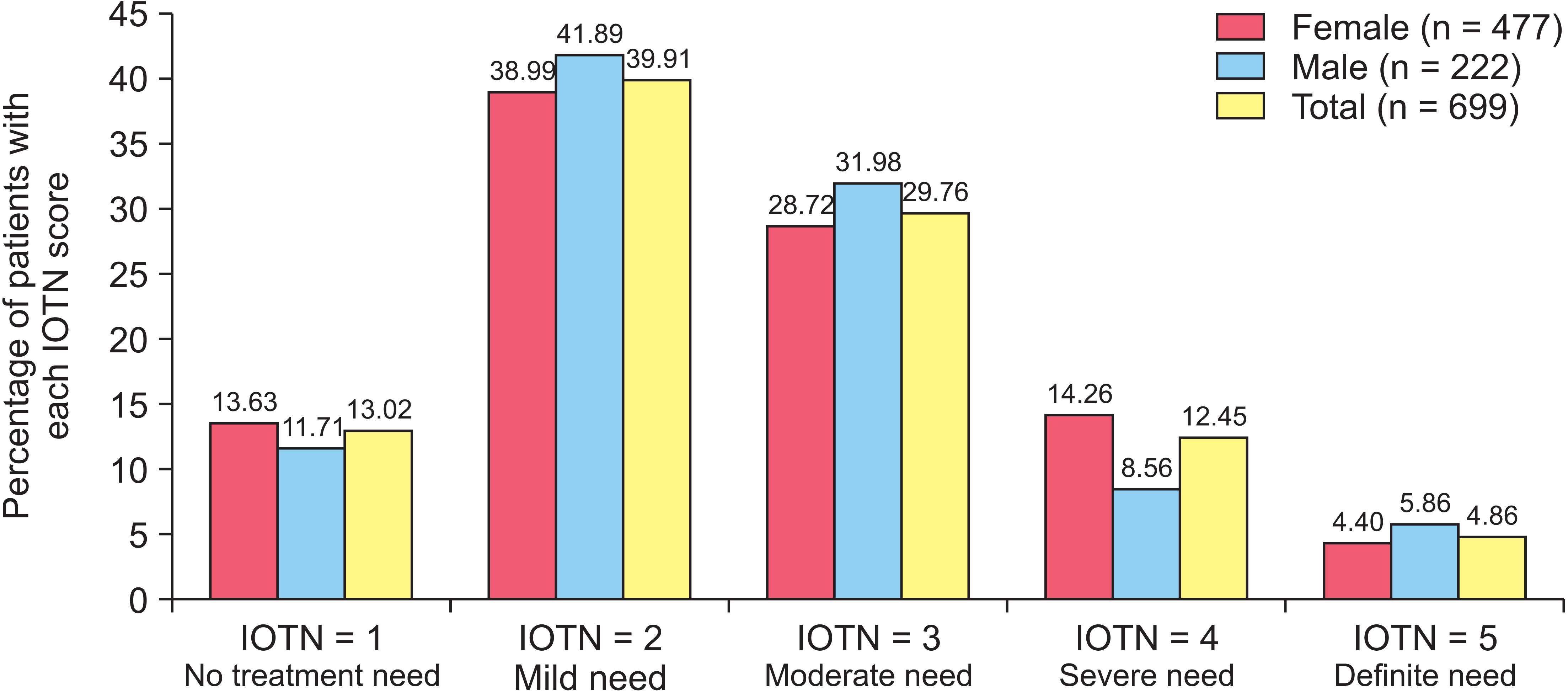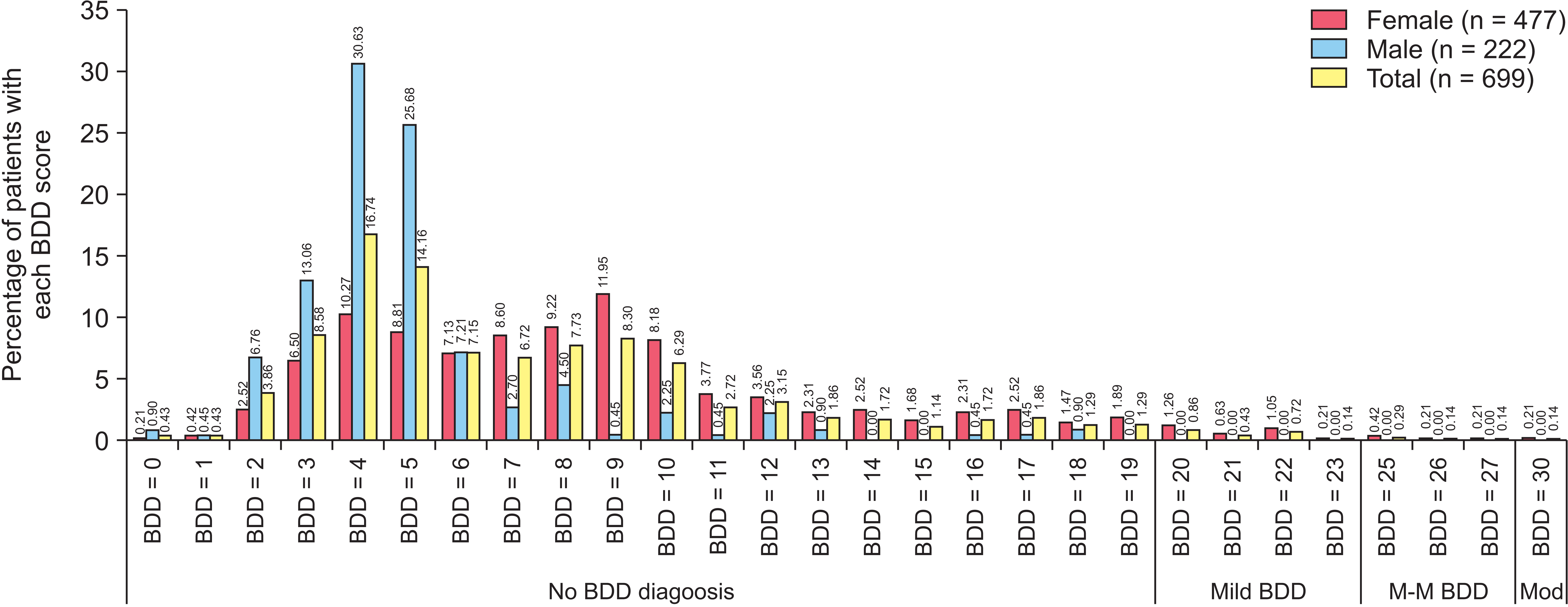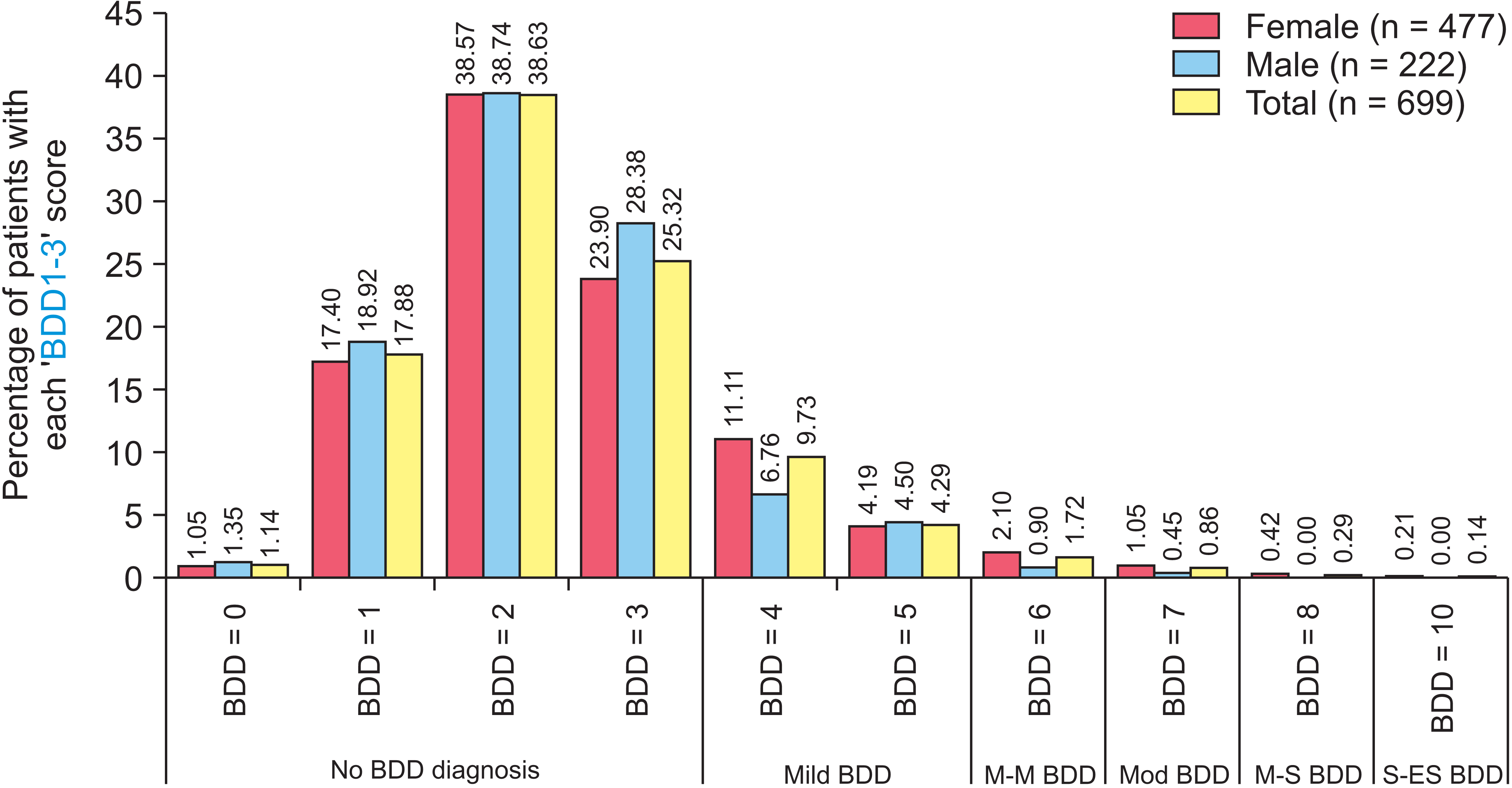1. Kerosuo H, Al Enezi S, Kerosuo E, Abdulkarim E. 2004; Association between normative and self-perceived orthodontic treatment need among Arab high school students. Am J Orthod Dentofacial Orthop. 125:373–8. DOI:
10.1016/j.ajodo.2003.04.009. PMID:
15014418.

2. Shue-Te Yeh M, Koochek AR, Vlaskalic V, Boyd R, Richmond S. 2000; The relationship of 2 professional occlusal indexes with patients' perceptions of aesthetics, function, speech, and orthodontic treatment need. Am J Orthod Dentofacial Orthop. 118:421–8. DOI:
10.1067/mod.2000.107008. PMID:
11029738.

3. Oshagh M, Salehi P, Pakshir H, Bazyar L, Rakhshan V. 2011; Associations between normative and self-perceived orthodontic treatment needs in young-adult dental patients. Korean J Orthod. 41:440–6. DOI:
10.4041/kjod.2011.41.6.440.

4. Momeni Danaie S, Asadi Z. 2003; Distribution of malocclusion types, hereditary crowding and the need of 7 9 year old children to serial extraction in Shiraz, 2000-2001. J Dent. 4:44–51.
5. Proffit WR, Fields HW, Sarver DM. 2014. Contemporary orthodontics. 5th ed. Elsevier Health Sciences;New York:
6. Shaw WC, Rees G, Dawe M, Charles CR. 1985; The influence of dentofacial appearance on the social attractiveness of young adults. Am J Orthod. 87:21–6. DOI:
10.1016/0002-9416(85)90170-8. PMID:
3855347.

7. Phillips B, Moulding R, Kyrios M, Nedeljkovic M, Mancuso S. 2011; The relationship between body dysmorphic disorder symptoms and self-construals. Clin Psychol. 15:10–6. DOI:
10.1111/j.1742-9552.2011.00004.x.

9. Albino JE, Lawrence SD, Tedesco LA. 1994; Psychological and social effects of orthodontic treatment. J Behav Med. 17:81–98. DOI:
10.1007/BF01856884. PMID:
8201614.

11. Schneider SC, Baillie AJ, Mond J, Turner CM, Hudson JL. 2018; The classification of body dysmorphic disorder symptoms in male and female adolescents. J Affect Disord. 225:429–37. DOI:
10.1016/j.jad.2017.08.062. PMID:
28858657.

12. Hepburn S, Cunningham S. 2006; Body dysmorphic disorder in adult orthodontic patients. Am J Orthod Dentofacial Orthop. 130:569–74. DOI:
10.1016/j.ajodo.2005.06.022. PMID:
17110253.

13. Avinash B, Avinash B, Shivalinga B, Jain S. 2013; Body dysmorphic disorder in orthodontic patients. World J Dent. 4:56–9. DOI:
10.5005/jp-journals-10015-1202.

14. Sadock BJ, Sadock VA, Ruiz P. 2017. Kaplan & Sadock's comprehensive textbook of psychiatry. 10th ed. Lippincott Williams & Wilkins;Philadelphia: DOI:
10.5005/jp-journals-10015-1202.
15. Sadock BJ, Sadock VA, Kaplan HI. 2003. Kaplan & Sadock's synopsis of psychiatry. Vol 2:Lippincott Williams & Wilkins;Philadelphia: p. 277–8. DOI:
10.5005/jp-journals-10015-1202.
16. Collins B, Gonzalez D, Gaudilliere DK, Shrestha P, Girod S. 2014; Body dysmorphic disorder and psychological distress in orthognathic surgery patients. J Oral Maxillofac Surg. 72:1553–8. DOI:
10.1016/j.joms.2014.01.011. PMID:
24582136.

17. Veale D, Gledhill LJ, Christodoulou P, Hodsoll J. 2016; Body dysmorphic disorder in different settings: a systematic review and estimated weighted prevalence. Body Image. 18:168–86. DOI:
10.1016/j.bodyim.2016.07.003. PMID:
27498379.

18. Yassaei S, Goldani Moghadam M, Aghili H, Tabatabaei SM. 2014; Body dysmorphic disorder in Iranian orthodontic patients. Acta Med Iran. 52:454–7. PMID:
25130153. PMID:
c42d51655d98408e92c1e5974c7a527b.
21. Aouizerate B, Pujol H, Grabot D, Faytout M, Suire K, Braud C, et al. 2003; Body dysmorphic disorder in a sample of cosmetic surgery applicants. Eur Psychiatry. 18:365–8. DOI:
10.1016/j.eurpsy.2003.02.001. PMID:
14643566.

23. Asgari I, Ebn Ahmady A, Khoshnevisan MH, Eslamipour F. 2012; Evaluation of the patient-based indices for orthodontic need assessment in the 13 to 18 year-old adolescents in Isfahan. J Dent Med. 25:124–34.
24. Rabiei M, Khormdel K, Kalantari K, Molavi H. 2010; Validity of the Yale-Brown obsessive compulsive scale modified for Body Dysmorphic Disorder (BDD) in students of the university of Isfahan. Iran J Psychiatry Clin Psychol. 15:343–50.
25. Phillips KA, Hollander E, Rasmussen SA, Aronowitz BR, DeCaria C, Goodman WK. 1997; A severity rating scale for body dysmorphic disorder: development, reliability, and validity of a modified version of the Yale-Brown Obsessive Compulsive Scale. Psychopharmacol Bull. 33:17–22. PMID:
9133747.
26. Phillips KA, McElroy SL, Dwight MM, Eisen JL, Rasmussen SA. 2001; Delusionality and response to open-label fluvoxamine in body dysmorphic disorder. J Clin Psychiatry. 62:87–91. DOI:
10.4088/JCP.v62n0203. PMID:
11247107. PMCID:
PMC4096700.

27. Phillips KA. 2005. The broken mirror: understanding and treating body dysmorphic disorder. Oxford University Press;Oxford:
28. Phillips KA, Menard W, Fay C, Weisberg R. 2005; Demographic characteristics, phenomenology, comorbidity, and family history in 200 individuals with body dysmorphic disorder. Psychosomatics. 46:317–25. DOI:
10.1176/appi.psy.46.4.317. PMID:
16000674. PMCID:
PMC1351257.

29. Bordner MA. 2007. A cognitive-behavioral treatment program for body dysmorphic disorder. ProQuest;Michigan:
31. Phillips KA. 2009. Understanding body dysmorphic disorder: an essential guide. Oxford University Press;Oxford:
33. Hamdan AM. 2004; The relationship between patient, parent and clinician perceived need and normative orthodontic treatment need. Eur J Orthod. 26:265–71. DOI:
10.1093/ejo/26.3.265. PMID:
15222710.

34. Souames M, Bassigny F, Zenati N, Riordan PJ, Boy-Lefevre ML. 2006; Orthodontic treatment need in French schoolchildren: an epidemiological study using the Index of Orthodontic Treatment Need. Eur J Orthod. 28:605–9. DOI:
10.1093/ejo/cjl045. PMID:
17095742.

35. Puertes-Fernández N, Montiel-Company JM, Almerich-Silla JM, Manzanera D. 2011; Orthodontic treatment need in a 12-year-old population in the Western Sahara. Eur J Orthod. 33:377–80. DOI:
10.1093/ejo/cjq086. PMID:
20926555.

36. Abu Alhaija ES, Al-Nimri KS, Al-Khateeb SN. 2005; Self-perception of malocclusion among north Jordanian school children. Eur J Orthod. 27:292–5. DOI:
10.1093/ejo/cjh094. PMID:
15947230.

37. Vulink NC, Rosenberg A, Plooij JM, Koole R, Bergé SJ, Denys D. 2008; Body dysmorphic disorder screening in maxillofacial outpatients presenting for orthognathic surgery. Int J Oral Maxillofac Surg. 37:985–91. DOI:
10.1016/j.ijom.2008.06.005. PMID:
18640822.

38. Phillips KA, Hollander E, Rasmussen SA, Aronowitz BR, DeCaria C, Goodman WK. 1997; A severity rating scale for body dysmorphic disorder: development, reliability, and validity of a modified version of the Yale-Brown Obsessive Compulsive Scale. Psychopharmacol Bull. 33:17–22. PMID:
9133747.
39. Perugi G, Akiskal HS, Giannotti D, Frare F, Di Vaio S, Cassano GB. 1997; Gender-related differences in body dysmorphic disorder (dysmorphophobia). J Nerv Ment Dis. 185:578–82. DOI:
10.1097/00005053-199709000-00007. PMID:
9307620.

41. Gupta R, Kaur S, Mahajan N, Kotwal B, Kharyal S, Gupta N. 2017; Prevalence of body dysmorphic disorder in adult Jammu population seeking orthodontic treatment. Int J Prev Public Health Sci. 3:25–7.
43. Phillips KA, McElroy SL, Hudson JI, Pope HG Jr. 1995; Body dysmorphic disorder: an obsessive-compulsive spectrum disorder, a form of affective spectrum disorder, or both? J Clin Psychiatry. 56 Suppl 4:41–51. discussion 52PMID:
7713865.
45. Koran LM, Abujaoude E, Large MD, Serpe RT. 2008; The prevalence of body dysmorphic disorder in the United States adult population. CNS Spectr. 13:316–22. DOI:
10.1017/S1092852900016436. PMID:
18408651.









 PDF
PDF Citation
Citation Print
Print



 XML Download
XML Download